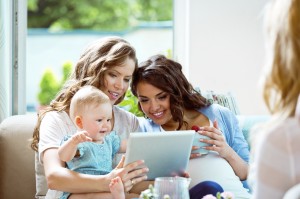
Back in 1995, a study by two child psychologists from the University of Kansas found that children whose parents were professionals were exposed to almost twice as many words as children in working class families; the latter in turn heard twice as many words as children in welfare families, the study noted.
In the ensuing years, much was made by governmental entities and developmental psychologists about exposing children, starting from birth, to a lot of words spoken by their parents and caregivers, which had been theorized by the study’s authors to be key to a child’s language acquisition and school success later on.
But studies published in 2014, including one presented at a recent White House conference on “bridging the word gap” between children from wealthier vs. lower-income homes, found that the quality of the words or dialogue to which babies and young children are exposed is even more important than the number of words they hear.
The lead author of the study presented at the White House, Kathryn Hirsh-Pasek, professor of psychology at Temple University in Philadelphia, underscored the importance of “fluid conversations” between parents and babies or toddlers, revolving around daily activities and rituals, and giving the children opportunities to babble back responses, with the parent acknowledging the child’s response. (Example: Caregiver –“We’re going to put your shirt on now.” Child — “Shirt.” Caregiver — “That’s right! We’ll put the shirt on.”)
Daily, engaged interactions between parent and child were a much better predictor of language skills by age 3 than any other factor, including how many words the child heard, the study found.
In a study published in April, 2014, researchers found that one-on-one interactions at home were important for language acquisition among 11- and 14-month-old children; the frequent use of “parentese” also seemed to help small children absorb language more readily. Parentese was defined as the high-pitched voice that parents often use to talk to their babies — baby talk.
One-on-one chatting and parentese were found to reliably predict language ability by age 2; the number of words to which the child was exposed in the first years of life was not found to be related to future ability. (And in fact, even the 1995 study, while emphasizing the number of words young children heard, also underlined that parental tone, responsiveness and use of symbols could enhance a child’s communication skills.)
Babbling, a Precursor to Words, Should Be Encouraged, Researcher Says
An author of the April 2014 study, Patricia Kuhl, PhD, co-director of the Institute for Learning and Brain Sciences at the University of Washington, encourages new parents to talk a lot of one-on-one baby talk to their infants; she noted that the 1-year-olds in her study were more inclined to babble when parents exaggerated vowels (example: “Want to go to the park and get on the swiiiing?”) and when parents raised the pitch of their voices. Baby talk was also most effective when a parent and an infant were alone, with no other children or adults around.
By Jamell Andrews